Trick training used to be primarily an activity for dogs, but that’s changing now. Cat owners are joining the fun and teaching their cats impressive tricks that even outshine their canine rivals, especially when it comes to their jumping abilities.
Try asking a golden retriever to jump on your shoulder or into a backpack, and you will see what I mean.
When starting your cat training journey, you might wonder about the easiest tricks for your cat to learn.
Consider all the behaviors your cat does naturally and work with those. Observe and note what actions are automatic for your cat.
Are they good at jumping? Do they love to use their paws?
Do they go up on their hind legs or roll over while you play with their favorite toy? Once you get to know your star student and see their natural talents, you can capture these behaviours and turn them into tricks.
The only thing you need is a training tool known as a “clicker” and some treats your cat loves.
What Is Clicker Training?
A clicker can be a useful training tool, allowing you to create clear cues that your cat can easily understand.
The clicker is a small handheld tool that makes a clicking sound. Think of a clicker like taking a snapshot of cat behavior.
A clicker will help you succeed in your trick training journey because it provides clear communication to your cat.
The clicker tells your cat which action earned a reward. Imagine you are teaching your cat to high five. Your cat sits and raises their paw. Now it’s time to reward them for all their hard work, so you give your cat a treat.
But wait, how does your cat know they got a treat for their paw vs sitting? They don’t. If you want your cat to know they earned a treat for the high five, you should click at the split second they raise their paw, so your cat knows the paw lift is the movement you are rewarding.
Once your cat learns what action makes you reward them, they will repeat it (this is the principle of positive reinforcement), and this feedback will make teaching new tricks a lot easier. When a cat offers behaviours to earn a click and a reward, we call them “clicker savvy.”
Introducing The Clicker
Before you begin your training sessions, you will need to introduce your cat to the clicking sound to let them know that one click equals one treat. With your cat’s attention, click and then toss a treat away to get them moving.
As soon as your cat comes back to get another reward, click and throw another piece of food. Pair EVERY click with a piece of food (always and forever); if you click without giving your cat a treat, they will get confused, and the clicker won’t provide proper communication.
Once your cat learns the association that one click equals one treat, you can start to use the clicker to build a repertoire of tricks.
1. Teach Your Cat To Sit
Once you understand the basics of clicker training, train your cat to sit on command.
Most cats move naturally into the sitting position, so that’s a purrfect first trick to hone your clicker training skills. Observe your cat and wait for them to sit. As soon as their fluffy butt hits the ground, click and toss a piece of food a few feet away.
By throwing a treat away, your cat will have to get up and get their reward, allowing you to practice another sit when they return. Repeat this training a lot to help your cat understand the connection between doing the behaviour (sit) and earning a reward.
Once your cat learns that they get a click and treat whenever they sit, you should see them sit and look at you in anticipation of their prize.
Now it’s time to add a signal to this behaviour, so your cat does it when you ask them to, and you can show off your kitty genius on social media. When you can predict with relative certainty that your cat will sit, start attaching a signal to the action.
Careful, we don’t want to nag your cat by saying: “SIT, SIT SIT!!!” otherwise, they’ll learn they can ignore you the first time you ask them to sit. We want your signal to be polished. Think one word, one time.
Say “Sit,” just as your cat is about to sit.
If you aren’t sure your cat will do it, spend more time capturing the sit with the clicker before pairing a verbal signal with the action. If you pair the word ‘Sit’ with the cat’s movement into the position, they will learn the verbal cue’s meaning. With enough practice, you should be able to say “Sit,” and your cat will know what to do.
The final step is ONLY to reward the ones where you ask the cat to do it.
Do not reinforce any random sits that your cat does, or your cat will turn into a little clown and follow you around sitting and staring at you, “HUMAN, DO YOU SEE?? I SITS!”
This behavior can be cute at first but not down the road when you teach lots of skills. For example, imagine teaching your cat to jump on your shoulder (fun). Now imagine your cat jumping on your shoulder when you aren’t looking (not fun!). When you teach your cat the signal to a trick, ONLY reward the cat when you signal your cat to do it.
You’ve conquered teaching your cat to sit; you’re officially a clicker training cat pro! Now you can apply this capturing method to other natural behaviours your cat does.
Find a cute action your cat does and capture it!
2. Teach Your Cat to Fist Bump
Training your cat to fist bump is an excellent trick for beginners.
Paw tricks are easy to teach because we can take advantage of a cat’s natural ability to use their paws to get treats.
Start by hiding treats in a small container.
The container should be small enough that your cat can’t stick their furry face inside to get the food; remember, our goal is for the cat to use their paw.
The cup should also be lightweight (plastic cups work best). Most importantly, you will need a high-value treat that your cat will want to get out of the container.
Once you have a cup to work with, you are ready to start training.
Rest the cup on its side, place a treat inside it and wait for your cat to use their paw to get the food. Click and reward that behaviour and repeat the exercise.
If your cat doesn’t try to get the treat out, take a step back from the training and focus on improving your cat’s foraging behaviour with food puzzles. Food puzzles are toys that encourage your cat to use their paws to ‘forage’ for treats.
By giving your cat these toys, you can introduce them to having to search for their food. If your cat is used to only eating from the bowl, this can be a giant leap for them, as they now need to work for their food.
Once your cat learns that you’ve signed them up for a new work-to-earn program and food isn’t for free anymore, try the cup training again.
Keep in mind foraging for food is healthy for your cat’s well-being. Many feline behaviorists recommend using food foraging as a form of feline enrichment.
If you’ve got your cat using their paw to get food out, congratulations!
We can now teach some paw tricks. Instead of having the cup on its side, turn it upright and click and reward for your cat’s paw touching the container. Your goal is to gradually raise the cup while continuing to reward your cat’s paw target.
Don’t rush your training; make sure your cat gets five in a row correctly before gradually raising the cup. If your cat places their paw under the cup, try increasing the cup’s height slowly by placing books underneath it to help them see the top of the cup is the correct choice.
It’s time to move away from putting the food in the cup.
We want the cat to learn that they will get a reward when they hit the cup even if there is no food visible. Pretend to put a treat in the cup. As soon as your cat hits it, click and reward them with a treat from your other hand. Now your cat learns the reward comes from your hands, not from the cup.
In the next few steps, start putting your hand around the cup and eventually over the cup, so your cat hits your fist.
If at any point in time your cat gets confused, go back and make it easier.
Can your cat hit the cup when your hand is holding it? Can your cat hit the cup when your hand partially covers the cup? Gradually practice until your cat hits the cup with your hand fully covering it. The final step is to fade the cup and only present your fist.
This type of training can take several sessions, so have fun and keep it easy, so your cat keeps winning. If your cat walks away, you’ve made it too hard.
3. Teach Your Cat to High Five
Once your cat has mastered the fist bump, it’s time to train them to high-five.
If the cat has a good paw target and you’ve got the fist bump, it’s time to level up your training: let’s teach your cat to touch a sticky note with their paw.
A sticky note is a great tool that you can use to teach many easy tricks. How do you get your cat to touch the sticky note? It’s easy; stick it to the cup!
Your cat already knows how to hit the cup with their paw, so we can use that skill to build another one.
Layer the sticky note on top of the cup and present the target to your cat with the sticky note facing them to encourage your cat to hit it correctly.
Can you fade the cup out of the picture and continue to get your cat to hit the note? If you can, you have mastered the art of teaching your cat tricks.
What else can you do with a sticky note?
Place the sticky note on your hand, and cue your cat to his the sticky note.
Suddenly you’ve got a beautiful high five. You can gradually make the sticky note smaller (cut it down), so it’s barely visible and eventually fade it out entirely, so your hand is the cue for a high five.
Put the note on the floor and see if your cat will put their paw on it. Move it around the room and practice teaching your cat to seek out the target and step on it. How do animal handlers train cats on movie sets? They use marks just like sticky notes. Your kitty is officially ready to be in commercials.
Your current trick tally: sit, fist bump, high five, and your cat moving to their sticky note around the room. Next up is finger target.
4. Teach Your Cat to Target Your Finger
Use treats to train your cat to target your finger. Once you’ve taught your cat to target your finger, you can use it as a useful guide in other tricks.
Your finger is a target that your cat should learn to follow. Begin teaching it by placing a treat down on the floor and pointing to it. Wait for your cat to walk over and get the food. Repeat this a bunch of times until your cat sees your finger and thinks, hey, I know there is a treat over there, I’m coming!!!
Now you’re ready to add in your clicker. Click whenever your cat approaches your finger. But this time, give your cat the treat from your other hand.
This exercise aims to get the cat to come to your finger without seeing the food. If your cat has trouble with this step, i.e., “I don’t see a treat, so I’m not coming…” pretend to put a treat down and click as soon as your cat approaches.
Always feed your cat food from your other hand – again, we want the cat to learn not to rely on seeing treats to do the behavior. Repeat this exercise while gradually raising your hand so you can use the finger as a guide.
5. Teach Your Cat To Jump
Once you’ve trained your cat to target your finger, you are able to train your cat to perform impressive jumping tricks.
Saving the best for last, we can use that finger target to teach jumping tricks. Cats are naturally agile, so it makes purrfect sense to teach them some jumping exercises.
Once your feline friend follows your finger target, practice guiding them over natural props in your house and your body parts. Your next assignment is to cue your cat to jump up on a chair and over a broomstick.
Combine Your Tricks Into a Routine
Now that you’ve got your kitty Einstein doing all sorts of simple tricks, you can start combining them. Use your finger to signal your cat to jump on a chair, ask your cat to sit, and give you a high five because, after all this hard work, you deserve it!
Frequently Asked Questions
What tricks can I teach my cat?
You can train your cat paw tricks, nose targets, paw targets (e.g., paw touching a sticky note and a container), and jumping tricks.
What is the easiest trick to teach a cat?
Any behavior your cat demonstrates naturally can be turned into a trick that you ask for with a signal.
Can I teach my kitten tricks?
Yes, kittens as young as ten weeks can learn tricks. Always keep training easy and fun, so your kitten enjoys participating in the activity. Short sessions (three-five minutes) are a good start for young kittens.
What do cats like the most?
Every cat is different and will have their preferences for tricks. Energetic cats may appreciate jumping tricks, while thoughtful cats may prefer brain games. Try to figure out what style of tricks your cat loves.
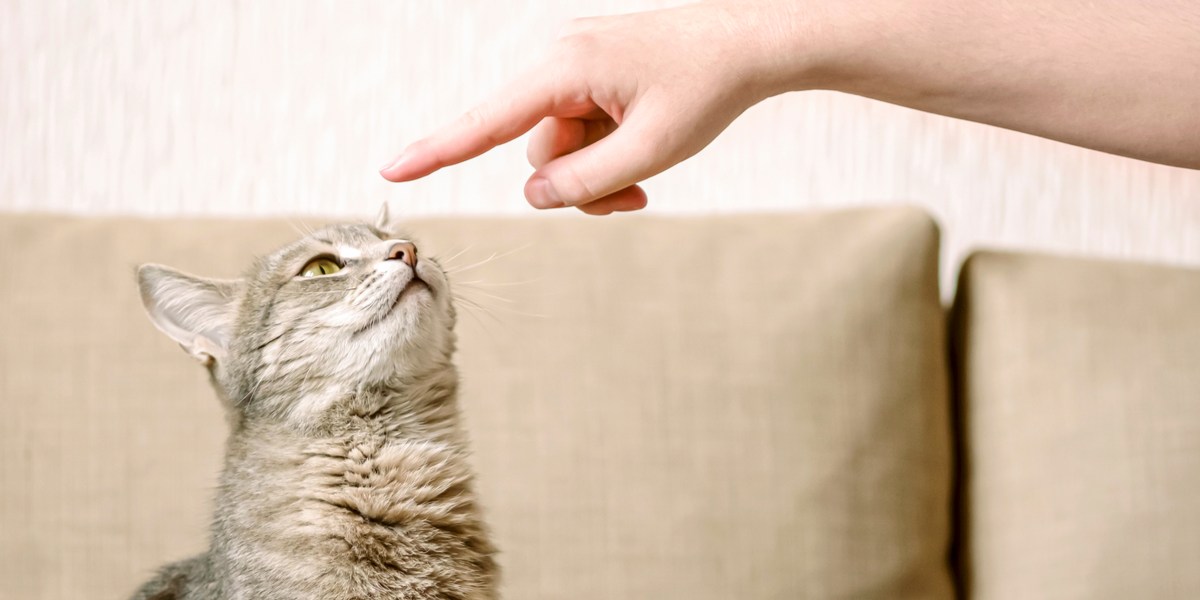
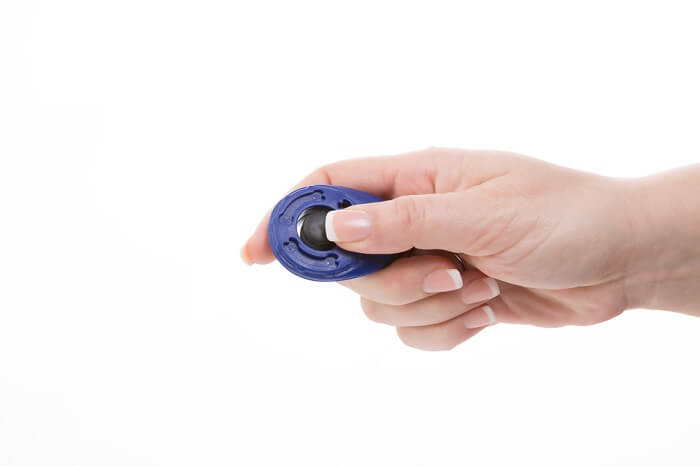
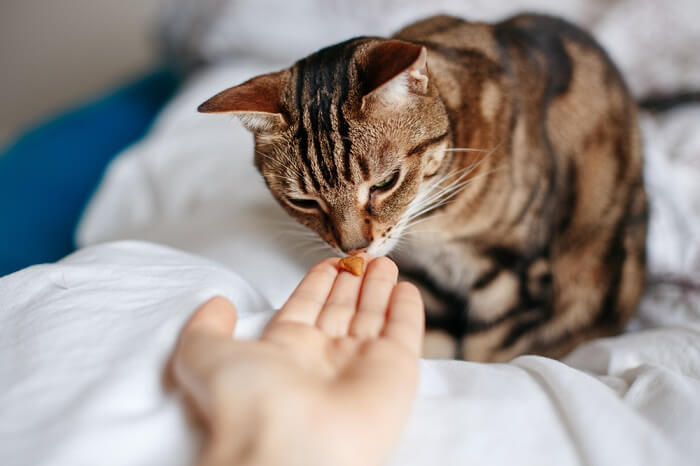
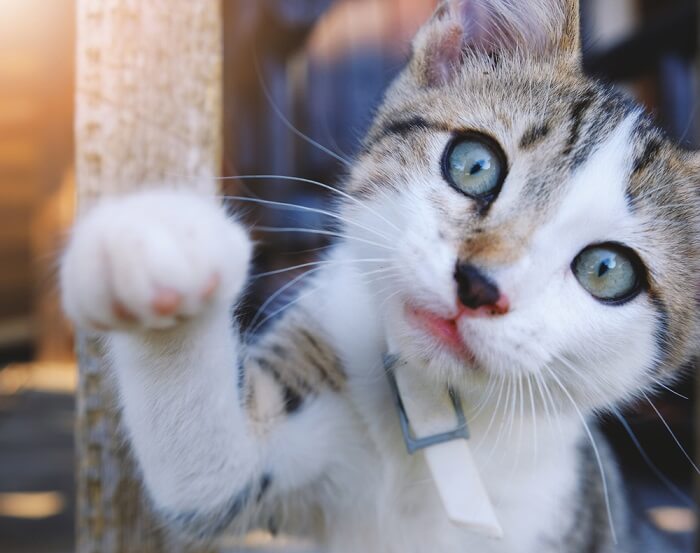
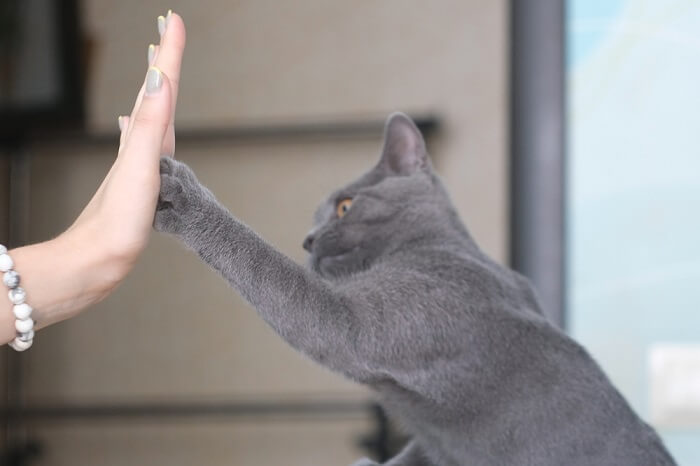
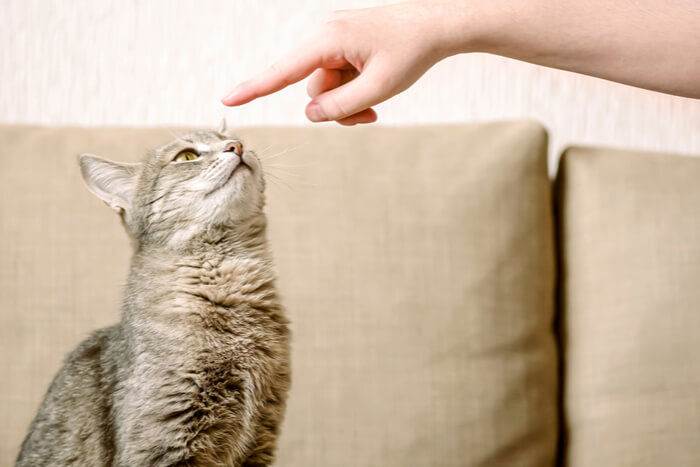

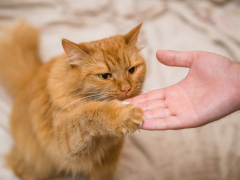
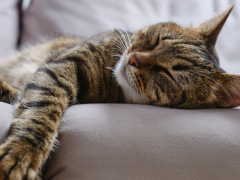



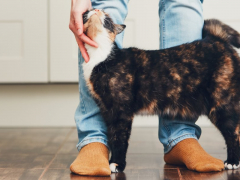
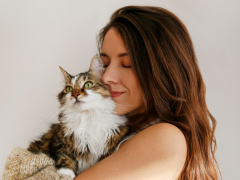

I would like to know if if it’s possible to incorporate clicker training into training a cat to wear a harness my cat’s about four years old and I can put it on her and she doesn’t fight but then she just lays down like she’s a log and will not move, thank you
Hi Kathleen – For harness training, we use a different method called desensitization. We present the harness at a level the cat can handle and pair the experience with food. We gradually expose the cat to the harness for more extended periods.
Where can I get a clicker?
Hi Terry, clickers are widely available. If you’d prefer to shop in-store, you can find them at any pet supply store like PetSmart or Petco. Online, you can buy them on Chewy or Amazon. Here’s a popular one: https://www.amazon.com/Dog-Training-Clicker-Wrist-Strap/dp/B07NKJHD9X
You can also buy a complete cat training kit from Cat School: https://www.catschool.co/products/cat-training-clicker
I enjoyed the article. I have gotten my cat to jump on cue, without any effort, as I noticed he likes to jump on things anyway, and he is very food motivated. I either place the treat on the object I want him to jump on, or i can just point and he will jump and the treat immediately follows. However, I have not been able to get him to jump using just the word jump without any physical cues. Does it seem likely that he will learn the word ‘jump’ without the gesture? Or should I focus instead on making the cue more subtle (like with dressage horses?)
Also, is there a neat tip or trick to get Leo to take a treat from my hand, on tiptoe, without using his paws? My cat quickly learned to stand on his hind legs for a treat, but though he seemed to pick up right away that I wanted him to take the treat out of my hands with his mouth (and I have even seen him make an effort to use his mouth more and his paws less) using his paws to guide the treat to his mouth has proven hard for him to break, and not giving him the treat because he used his paws sounds excessively frustrating (for him.) Any thoughts?